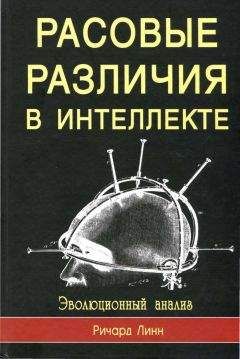Gobineau, A. de (1853). essai sur Tinegalite des races humaines. Paris: Didot.
Godman, A. (1964). The attainments and abilities of Hong Kong primary IVpupils: a first study. Hong Kong: Hong Kong University Press.
Goodall, J. (1986). The Chimpanzees of Gombe: Patterns of Behavior. Cambridge, MA: Cambridge University Press.
Goodenough, F. L. (1926a). The Measurement of Intelligence by Drawings. New York: World Books.
Goodenough, F. L. (1926b). Racial differences in the intelligence of school children. Journal of Experimental Psychology, 9, 388-397.
Goodenough, F. L., and Harris, D. B. (1950). Studies in the psychology of children’s drawings: 11, 1928-49. Psychological Bulletin, 27, 396-433.
274
Ричард Линн
Goosens, G. (1952а). Etalonnage du Matrix 1947 de J. C. Raven. Revue Beige de Psychologie et de Pedagogie, 14, 74-80.
Goosens, G. (1952b) Une application du test d’intelligence de R.B
Gordon, E. E. (1980). Developmental music aptitudes among inner city primary children.
Bulletin Council for Research in Music Education, 63, 25-30.
Gott, B. (2002). Fire making in Tasmania: absence of evidence is not evidence of absence.
Current Anthropology, 43, 650-655.
Gottfredson, L. S. (1997). Editorial: Mainstream science on intelligence. Intelligence, 24, 13-24.
Gottfredson, L. S. (2005). What if the hereditarian hypothesis is true? Psychology, Public Policy, and Law, 11, 311-319.
Gould, R. A. (1969). Subsistence behaviour among the Western Desert Aborigines of Australia. Oceania, 39, 253-274.
Gould, S. J. (1978). Morton’s ranking of races by cranial capacity. Science, 200, 503-509. Gould, S. J. (1981; 1996). The Mismeasure of Man. New York, Norton. Grantham-McGregor, S, М., and Hawke, W. A. (1971). Developmental assessment of Jamaican infants. Developmental Medicine and Child Neurology, 13, 582-589. Grantham-McGregor, S. М., Powell, C., Walker, S. P., and Himes, J. H. (1991).
Nutritional supplementation, psychosocial stimulation and the mental development of stunted children: the Jamaica study. The Lancet, 338, 1-5.
Grantham-McGregor, S. М., Powell, C., Walker, S. P., Chang, S., and Fletcher, P. (1994). The long-term follow-up of severely malnourished children who participated in an intervention program. Child Development, 65, 428-439.
Grantham-McGregor, S. М., Walker, S. P., and Powell, C. (1994). Methodological approaches used in Kingston, Jamaica, to determine the effect of nutrition and stimulation on child development. In J. B. Stanbury (Ed.). The Damaged Brain of Iodine Deficiency. New York: Cognizant Communication.
Graves, J. L. (2002). An anthropologist looks at race and IQ testing. In J. M. Fish (Ed.).
Race and Intelligence. Mahwah, NJ: Lawrence Erlbaum.
Greenfield, P. M. (1998). The cultural evolution of IQ. In U. Neisser (Ed.). The Rising Curve: Long Term Gains in IQ and Related Matters. Washington, D.C.: American Psychological Association.
Grieve, K. W, and Viljoen, S. (2000). An exploratory study of the use of the Austin maze in South Africa. South African Journal of Psychology, 30, 14-18.
Grigorenko, E. L., and Sternberg, R. J. (2001). Analytical, creative and practical
intelligence as predictors of self-reported adaptive functioning: a case study in Russia. Intelligence, 29, 57-73.
Grine, R E., and Kay, R. R (1988). Early hominid diets from quantitative image analysis of dental microwear. Nature, 333, 765-768.
Groves, C. P. (1991). Genes, genitals and genius: the evolutionary ecology of race. In P. O’Higgins (Ed.). Human Biology: An Integrative Science. Perth, Australia: Center for Human Biology.
Guenole, N., Englert, P., and Taylor, P. J. (2003). Ethnic group differences in cognitive ability test scores within a New Zealand applicant sample. New Zealand Journal of Psychology, 32, 49-54.
Guidon, N., and Delibrias, G. (1986). Carbon-14 dates point to man in the Americas 32,000 years ago. Nature, 321, 769.
Gupta, G. C., and Gupta, S. (1966). Norms for Raven’s Colored Progressive Matrices. Manus, 13, 87-89.
Gupta, S. (1991). Effects of time of day and personality on intelligence test scores.
Personality and Individual Differences, 12, 1227-1231.
Gustafsson, J. E. (1984). A unifying model of the structure of mental abilities. Intelligence, 8, 179-203.
Расовые различия в интеллекте
275
Guthke, J., and Al-Zoubi, А. (1987). Kulturspezifische Differenzen in den Coloured Progressive Matrices (CPM) und in einer Lemtestvariante der CPM. Psychologie in Erziehung und Unterricht, 34, 306-311.
Hadidjaja, P., Bonang, E., Suyardi, A., Abidin, A. N., Ismid, I. S., and Margono, S. S. (1998). The effect of intervention methods on nutritional status and cognitive function of primary school children infected with ascaris lumbri-coides. American Journal of Tropical Medicine, 59, 791-795.
Halpem, D. (2000). Sex Differences in Cognitive Abilities. Mahwah, N. J.: Lawrence Erlbaum.
Halsey, A. H. (1972). Educational Priority. Volume 1. London: HMSO.
Hamers, J. H. М., Hessels, M. G. P., and Pennings, A. H. (1996). Learning potential of ethnic minority children. European Journal of Psychological Assessment, 12, 183-192.
Hammer, М. E, Redd, A. J., and Wood, E. T. (2000). Jewish and Middle Eastern non- Jewish populations share a common pool of Y-chromosome biallelic haplotypes. Proceedings of the National Academy of Sciences, 97, 6769-6774.
Hanushek, E. A., and Kimko, D. D. (2000). Schooling, labor force quality, and the growth of nations. American Economic Review, 90, 1184-1208.
Harker, R. K. (1978). Achievement and ethnicity: environmental deprivation or cultural difference. New Zealand Journal of Educational Studies, 13, 107-124.
Harris, S. A. (1977). Milingimbi Aboriginal Learning Contexts. Ph.D. dissertation, University of New Mexico, Albuquerque, New Mexico.
Hart, J. A. (1965). A study of Cognitive Capacity of a Group of Australian Aboriginal Children. M. A. thesis, University of Queensland.
Harvey, P. H., and Glutton-Brock, Т. H. (1985). Life history variation in primates. Evolution, 39, 559-581.
Haught, B. F. (1934). Mental growth of the southwest Indians. Journal of Applied Psychology, 18,419-433.
Havighurst, R. J., and Hilkevitch, R. R. (1944). The intelligence of Indian children measured by a performance scale. Journal of Abnormal and Social Psychology, 39,419-433.
Hayden, B. (1981). Subsistence of Modem Hunter Gathers. In R. O. S. Harding and G. Telela (Eds.). Omnivorous Primates. New York: Columbia Univ. Press.
Heim, A. W. (1968). AH4 Group Test of General Intelligence Manual. Slough,UK:
National Foundation for Educational Research.
Helms-Lorenz, М., Van de Vijver, F. J. R., and Poortinger, Y. P. (2003). Cross-cultural differences in cognitive performance and Spearman’s hypothesis. Intelligence, 31, 9-29.
Henneberg, M. (1983). Trends in cranial capacity and cranial index in sub-Saharan Africa during the Holocene. American Journal of Human Biology, 5, 473-479.
Henneberg, M. (1984). Comment on Beals Dodd and Smith. Current Anthropology, 25, 321-322.
Henneberg, М., Budnik, A., Pazacka, М., and Puch, A. E. (1985). Head size, body size and intelligence: introspecific correlations in Homo sapiens. Homo, 36, 207-218.
Herrnstein, R. J., and Murray, C. (1994). The Bell Curve: Intelligence and Class Structure in American Life. New York: Free Press.
Hertzig, М., Birch, H. G., Richardson, S. A., and Tizard, J. (1972). Intellectual levels of school children malnourished during the first two years of life. Pediatrics, 49, 814-824.
Hetzel, B. S. (1994). Historical development of the concepts of brain-thyroid relationships. In J. B. Stanbury (Ed.). The Damaged Brain of Iodine Deficiency. New York:
Cognizant Communication Corporation.
Heyneman, S. P., and Jamison, D. T. (1980). Student learning in Uganda. Comparative Education Review, 24, 207-220.
Hirszfeld, L., and Hirszfeld, H. (1919). Essai d’application des methods au probleme des races. Anthropologies 29, 505-537.
Ho, H. — Z., Baker, L. A., and Decker, S. N. 1988. Covariation between intelligence and speed of cognitive processing: genetic and environmental influences. Behavior Genetics, 18, 247-261.
10*
276
Ричард Линн
Но, К. — С, Roessmann, U., Straumfjord, J. V., and Monroe, G. (1980). Analysis of brain weight: 1 & 11. Adult brain weight in relation to sex, race and age. Archives of Pathology and Laboratory Medicine, 104, 635-639; 640-645.
Holding, P. A., Taylor, H. G., Kazungu, S. D., and Mkala, T. (2004). Assessing cognitive outcomes in a rural African population: development of a neuro-psychological battery in Kilifi district, Kenya. Journal of the International Neuropsychological Society, 10, 246260.
Horn, J. L. (1991). Measurement of intellectual capabilities: a review of theory. In K. S. McGrew, J. K. Werder, and R. W. Woodcock (Eds.). Woodcock-Johnson Technical Manual. Chicago: Riverside.
Houghton, V. (1966). Intelligence testing of West Indian and English children. Race, 8, 147-156.
Howell, R. J., Evans, L., and Downing, L. N. (1958). A comparison of test scores from the 16-17 year age group of Navajo Indians with standardisation norms from the WAIS. Journal of Social Psychology, 47, 355-359.
Hsu, С. — C. (1971). Chinese children’s responses to Raven’s Colored Progressive Matrices. Journal of the Formosan Medical Association, 70, 579-593.
Hsu, С. — C., See, R., and Lin, C-C. (1973). Assessment of learning potential of Chinese children with Raven’s Standard Progressive Matrices. Journal of the Formosan Medical Association, 72, 658-670.
Hsu, С. — C. (1976). The learning potential of first graders in Taipei city as measured by Raven’s Coloured Progressive Matrices. Acta Pediatrica Sinica, 17, 262-274.
Humphreys, L. G. (1988). Trends in level of academic achievement of blacks and other minorities. Intelligence, 12, 231-260.
Hunkin, V. (1950). Validation of the Goodenough Draw-a-Man test for African children. Journal for Social Research, 1, 52-63.
Hunter, B., and Schwab, R. G. (1998). The determinants of indigenous educational outcomes. Canberra: Australian National University,





